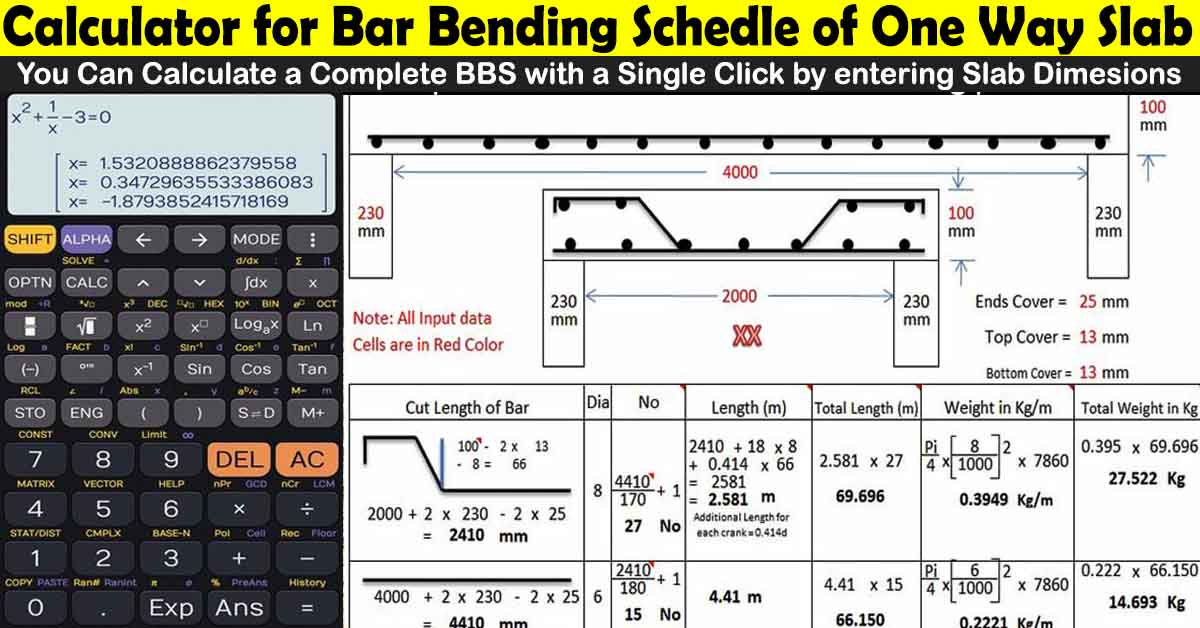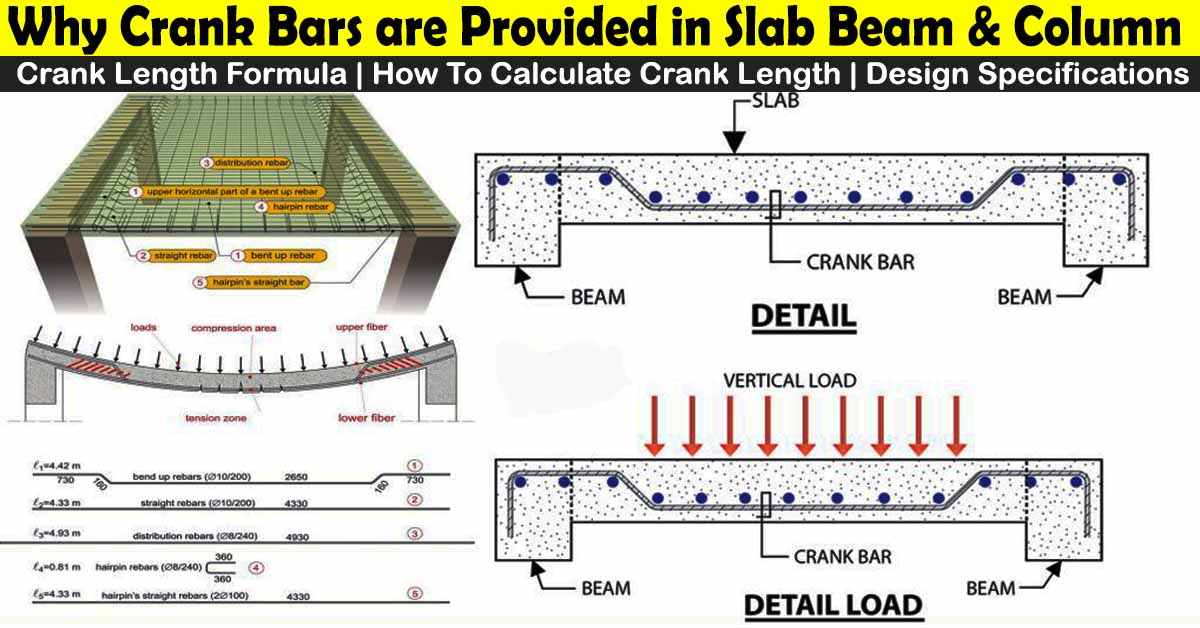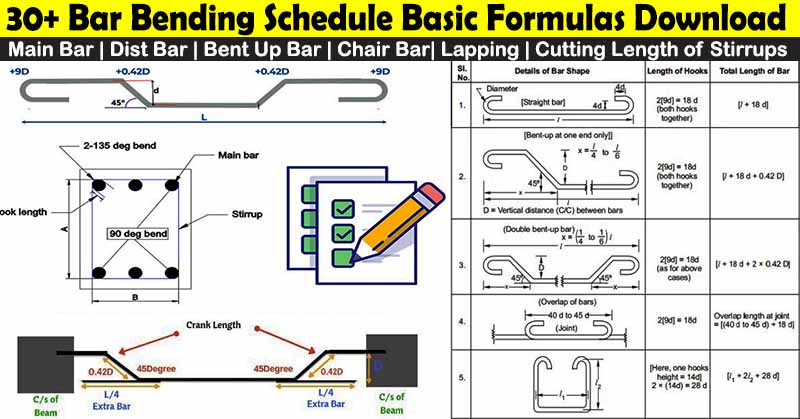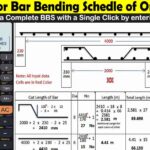Last updated on: October 30, 2024
Main Bars and Distribution Bars in Slab Construction: Functions and Importance
If you’re in the construction industry or planning to build a structure, you’ve likely come across the terms “main bars” and “distribution bars“–two words commonly used in constructing slabs. This article will explore these terms, their functions, and their importance in slab construction.
What are Main Bars?
“The main bars are the reinforcement bars positioned in the slab’s tension zone (shorter span) to resist the bending moment and transmit the superimposed loads to the slab’s provided supports.”
As shown in the above drawing, the main bars are always positioned at the bottom of the slab reinforcement, and distribution bars sit on top of the main bar. For the HYSD bar and plain bars, the primary bar’s diameter should not be less than 8mm and 10mm, respectively.

Functions of Main Bars:
The main bars provide the following functions in slab construction:
-
Load-bearing Capacity
The main bars are the primary structural members of a building. They carry the structure’s load, transferring it to supporting columns and beams. -
Prevent Cracking
Main bars also prevent the slab from cracking because they resist tensile stresses. When you load a slab, the main bars resist the tension that would otherwise cause cracking. -
Structural Integrity
The main bars provide structural integrity to the slab, ensuring it remains stable and robust.
What are Distribution Bars?
“Distribution reinforcement bars, also known as transverse bars, are reinforcing bars that run perpendicular (in a longer span) to the main bars in the slab. They are placed in the top layer of the slab and are responsible for distributing the load across the entire slab.”

Functions of Distribution Bars
The distribution bars provide the following functions in slab construction:
1. Load Distribution
The distribution bars’ primary function is evenly distributing the load across the slab. They ensure that the load is not concentrated in one area, which could cause cracking or failure.
2. Prevent Shear Failure
Distribution bars also prevent shear failure by reinforcing the slab against horizontal forces that could cause it to slide or fail.
3. Improve Durability
The distribution reinforcement improves the durability of the slab by reducing the likelihood of cracking and enhancing its resistance to wear and tear.
Are Distribution Bars provided in a Two-Way Slab?
The word distribution reinforcement bar sometimes refers to the top reinforcement of all slab types. However, this is not right in a two-way slab because the load is transferred in both directions. As a result, in two-way slabs, the reinforcement given in the Lx and Ly directions should be referred to as the primary reinforcement bars. But in the One Way Slab, it is called distribution.
How are Main Bars and Distribution Bars Placed in Slab Construction?
The slab’s design specs install the main bars and distribution bars. The load needs, and the span of the slab decide the spacing, size, and placement of the bars. The main bars are usually positioned in the slab’s bottom layer, with a minimum cover distance of 20mm from the slab’s bottom. The distribution bars are installed in the slab’s top layer, with a minimal cover distance of 15mm from the slab’s top.
Importance of Main Bars and Distribution Bars in Slab Construction
The use of main bars and distribution bars in slab construction is crucial to the structural integrity of the building. Without them, the slab would be unable to bear the structure’s load and would be susceptible to cracking and failure. The placement of the main and distribution steel must also be precise to ensure that they can perform their intended functions. Improper placement or spacing of these bars could result in structural failure, compromising the safety of the building and its occupants.
Common Mistakes to Avoid When Using Main Bars and Distribution Bars
While using main reinforcement bars and distribution reinforcement bars is critical to the success of slab construction, several common mistakes must be avoided. Some of these mistakes include the following:
- Short cover distance: The cover distance of the bars is critical to their performance. If the cover distance is inadequate, it can lead to corrosion, reducing the effectiveness of the bars.
- Improper placement: If the main bars and distribution bars are not correctly installed, they may be unable to perform their intended functions, putting the building’s safety at risk.
- Poor spacing: When the bars are spaced too far apart, the load may not be evenly distributed and thus could lead to cracking or failure.
- Poor quality bars: The quality of the bars used is critical to their performance. Poor-quality bars can compromise the structural integrity of the building.
Advantages of Using Main Bars and Distribution Bars in Slab Construction
The main reinforcement bars and distribution reinforcement bars used in slab construction provide several advantages, including:
- Improved strength: The primary function of these bars is to improve the strength and load-bearing capacity of the slab, making it capable of supporting the weight of the building and its occupants.
- Reduced cracking: The bars resist tensile stresses that could cause cracking, improving the durability of the slab.
- Enhanced safety: Proper placement and spacing of these bars improve the safety of the building, reducing the risk of structural failure and protecting the occupants.
Disadvantages of Using Main Bars and Distribution Bars in Slab Construction
While the use of main steel and distribution steel are provided numerous benefits, there are also some disadvantages to consider, such as:
- Increased cost: Using these bars adds to the cost of slab construction, increasing the overall project cost.
- Time-consuming: Proper placement and spacing of these bars require careful planning and execution, which can be time-consuming.
- Corrosion: If the cover distance of the bars is insufficient, it can lead to corrosion, reducing their effectiveness and compromising the structural integrity of the building.
Main Bars and Distribution Bars Formula:
To calculate the required amount of main bars and distribution bars, the following formulas are used:
Calculation of Main Bars
The number of main bars required can be calculated using the following formula: n = (As * fy * d) / (0.87 * fyk * fctm) Where:
- n = number of bars
- As = cross-sectional area of a single bar
- fy = characteristic yield strength of steel
- d = effective depth of the section
- fyk = characteristic strength of steel
- fctm = mean compressive strength of concrete
Calculation of Distribution Bars
The number of distribution bars required can be calculated using the following formula: Asw = (0.08 * bw * s * fyk) / (0.4 * fctm) Where:
- Asw = total cross-sectional area of all stirrups in one meter length of beam
- bw = width of beam
- s = spacing between stirrups
- fyk = characteristic strength of steel
- fctm = mean compressive strength of concrete
for finding the cutting length of main bars and distribution bars with all related formulas: Bar Bending Schedule Formulas
Related Posts:
- Bar Bending Schedule – A Step-By-Step Guide For Rebars BBS
- 90+ Thumb Rules For Civil Engineering & Quantity Surveyors | Formulas
- Method Statement For Cast In Place Concrete Works
Conclusion
The main bars and distribution bars in slab are critical components of slab construction, providing load-bearing capacity, preventing cracking, improving durability, and enhancing safety. Proper placement and spacing of these bars are crucial to their performance, and care must be taken to avoid common mistakes that could compromise their effectiveness. While their use has some disadvantages, the benefits outweigh the costs, making them essential to the success of slab construction. You can better under stand the concept of main bars and distribution bars in slab by reading article: BAR BENDING SCHEDULE







Very informative and interesting educative thank you very much
Thanks for comment, For more related posts please visit Civil, Arch, Electrical and Mechanical Tab in File menu
I need the PDF copy.
What an important content this is!
sir
How can i got your pdf document, which are contain the detail explanation of main and distiribution bars?